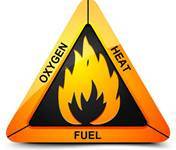Thermodynamics and its application

Overview about Thermodynamics : Thermodynamics is a Greek word meaning Heat power (therm-heat,dynamics-power).The study about heat,pressure,density etc and its transfer is called as thermodynamics.In our daily life we see applications of thermodynamics from bed to bed.For example you are waking in morning and eating your breakfast ,your breakfast is product of vegetables and raw materials by heat there exist thermodynamics some other examples are your digestion process,your vehicle engine,electric components like fridge,ac,etc.Thermodynamics is applied to variety of topics in science and engineering. Some important terms in thermodynamics are :
Fire Triangle : The triangle for fire consists of three side they are heat,fuel and oxygen if one part of this triangle is removed Fire cannot be formed.
Thermal contact : If two substance are connected there exist a heat flow it is called as Thermal contact.
Thermal Transfer : If a hot substance kept near a cold substance the flows from hot region to cold region is called thermal transfer.There are three types of heat transfer they are,
Conduction : In conduction heat is transferred in the same medium like if you heat one end of a iron rod another end gets heated.
Convection : Heat transfer one one compound to another compound without any direct contact is called as convection example heating water by a vessel.
Radiation : Transfer of heat from one medium to other medium in the form of light is called radiation example sun we get sun's heat in the form of radiation.
Thermal Equilibrium : When a hot substance is placed near a cold substance the heat of a hot substance transfers to the cold substance and both gets same temperature it is called thermal equilibrium
Thermal Expansion : If substances volume increases with temperature is called as thermal expansion and thermal contraction also occurs.
States of Matter : The five states of matter are,
Solid Atoms are tightly bonded.
Liquid Atoms are loosely bonded.
Gas Atoms are more loosely bonded.
Plasma Ionized gas is called plasma some examples are stars,nebula,flame and lightning.
Super fluid Fluid with zero viscosity.
Easy Math Editor
This discussion board is a place to discuss our Daily Challenges and the math and science related to those challenges. Explanations are more than just a solution — they should explain the steps and thinking strategies that you used to obtain the solution. Comments should further the discussion of math and science.
When posting on Brilliant:
*italics*or_italics_**bold**or__bold__paragraph 1
paragraph 2
[example link](https://brilliant.org)> This is a quote# I indented these lines # 4 spaces, and now they show # up as a code block. print "hello world"\(...\)or\[...\]to ensure proper formatting.2 \times 32^{34}a_{i-1}\frac{2}{3}\sqrt{2}\sum_{i=1}^3\sin \theta\boxed{123}Comments
There are no comments in this discussion.